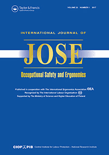
International Journal of Occupational Safety and Ergonomics
Scope & Guideline
Connecting academia and industry for enhanced safety.
Introduction
Aims and Scopes
- Occupational Safety Management:
Research dedicated to understanding and improving safety management systems in diverse industries, focusing on risk assessment, safety culture, and the implementation of safety protocols. - Ergonomics and Human Factors:
Exploration of ergonomic principles and human factors engineering to enhance workplace design, tool usability, and worker comfort, ultimately reducing the risk of musculoskeletal disorders. - Workplace Health and Well-being:
Studies on the physical and mental health of workers, including the impact of workplace conditions on health outcomes, stress management, and the promotion of health initiatives. - Technological Innovations in Safety:
Investigating the role of technology, such as wearable devices and AI, in enhancing occupational safety and ergonomics, including real-time monitoring and predictive analytics. - Behavioral Safety:
Examining the psychological and social factors influencing worker behavior and safety compliance, with a focus on interventions to promote safer work practices.
Trending and Emerging
- Digital Health and Safety Technologies:
An increasing number of studies are exploring the application of digital tools and technologies, such as AI and wearable devices, to enhance workplace safety and ergonomics. - Mental Health in Occupational Settings:
Research focusing on the psychological aspects of work, including stress, burnout, and mental well-being, has gained momentum, reflecting a broader recognition of mental health's impact on workplace safety. - COVID-19 Related Safety Protocols:
The pandemic has prompted a surge in research addressing safety protocols and practices related to COVID-19, influencing workplace health strategies and emergency preparedness. - Sustainable Workplace Practices:
Emerging interest in sustainability within occupational safety and ergonomics, focusing on environmentally friendly practices and their impact on worker health and safety. - Data Analytics and Predictive Modeling:
The application of data analytics and predictive modeling in understanding and preventing workplace incidents is a growing area of interest, reflecting advancements in research methodologies.
Declining or Waning
- Traditional Ergonomic Assessments:
There is a noticeable decline in studies solely focused on conventional ergonomic assessments, as more emphasis is placed on integrating technology and innovative methodologies for ergonomic evaluations. - General Occupational Health Studies:
Research that addressed broad aspects of occupational health without specific focus on ergonomics or safety management is becoming less frequent, as the field shifts towards more targeted and integrated studies. - Static Posture Analysis:
The trend towards dynamic and task-based assessments is overshadowing traditional studies focused on static posture, leading to fewer publications on this topic.
Similar Journals
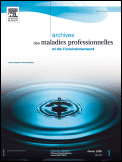
Archives des Maladies Professionnelles et de l Environnement
Advancing Knowledge in Occupational and Environmental HealthArchives des Maladies Professionnelles et de l'Environnement is a vital scholarly journal published by Elsevier Science Inc, focusing on the critical intersections of public health, environmental issues, and occupational health. With an ISSN of 1775-8785 and an E-ISSN of 1778-4190, this French-based journal serves as a platform for researchers, professionals, and students to explore contemporary challenges and advancements in these essential fields. Although it holds a Q4 ranking in the 2023 Scopus quartiles, it provides a unique opportunity for new contributions that can drive future research directions. The journal accepts a variety of article types, with the aim of spreading knowledge that can influence policy and improve practices in occupational health and environmental safety. As we approach the convergence of its publication years from 2004 to 2024, the journal remains committed to fostering a comprehensive understanding of the impact of work and environmental exposure on health, making it an important resource for anyone invested in these disciplines.
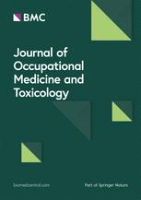
Journal of Occupational Medicine and Toxicology
Empowering research for a healthier workforce.The Journal of Occupational Medicine and Toxicology, published by BMC, is a pivotal open access journal that has been at the forefront of advancing knowledge in the fields of workplace health, environmental safety, and toxicology since its inception in 2006. With a robust impact factor and a distinguished reputation, this journal occupies a significant position in academic rankings, including Q2 in Public Health and Occupational Health, and Q1 in both Safety Research and Toxicology for 2023. Renowned for its rigorous peer-review process, it serves as a vital resource for researchers, professionals, and students aiming to disseminate and access high-quality research and innovative practices in occupational health and toxicological studies. Based in the United Kingdom, the journal prioritizes global access to research, ensuring that critical information reaches a diverse audience, conducive to the advancement of public health and safety. As it converges towards 2024, the journal continues to lead discussions that shape policies and practices related to workforce environments, chemical exposure, and preventative strategies in health management.

INTERNATIONAL ARCHIVES OF OCCUPATIONAL AND ENVIRONMENTAL HEALTH
Elevating Standards in Occupational and Environmental HealthINTERNATIONAL ARCHIVES OF OCCUPATIONAL AND ENVIRONMENTAL HEALTH is a prestigious journal published by Springer that serves as a vital resource in the field of public health and occupational safety. With its ISSN 0340-0131 and E-ISSN 1432-1246, this journal has been a cornerstone for researchers and professionals since its inception in 1975, converging knowledge and insights to enhance health practices and policies. Rated in the top Q1 category for both Public Health and Environmental and Occupational Health as of 2023, it currently ranks 154 out of 665 in Scopus, placing it in the 76th percentile, underscoring its significant impact within the scientific community. Although the journal does not offer open access, it provides invaluable content covering various aspects of environmental health, occupational safety, and epidemiological studies, making it a must-read for anyone vested in improving health outcomes across diverse populations. Located in Germany with an office at One New York Plaza, Suite 4600, New York, NY 10004, United States, the journal is committed to advancing knowledge and fostering collaboration among its readership.

OCCUPATIONAL MEDICINE-OXFORD
Pioneering Research for Healthier Work EnvironmentsOccupational Medicine-Oxford is a leading journal in the fields of public health and occupational health, published by Oxford University Press. With an ISSN of 0962-7480 and an E-ISSN of 1471-8405, this esteemed journal has been disseminating critical research findings since its inception in 1948. Ranked in the Q2 category for both Medicine (miscellaneous) and Public Health, Environmental, and Occupational Health, it occupies a significant spot in the academic community, with a Scopus ranking of #147 out of 665 in its categories, placing it within the 77th percentile. The journal aims to enhance the understanding of occupational health issues and promote practices that improve worker safety and well-being. As a vital resource for researchers, professionals, and students alike, Occupational Medicine-Oxford provides insights into emerging trends, comprehensive reviews, and original research articles that pave the way for future innovations in occupational health strategies. Explore the journal for the latest developments in this critical field, and gain access to a wealth of knowledge that can make a meaningful impact on public health policies and occupational practices worldwide.

SAFETY SCIENCE
Elevating global safety standards through rigorous scholarship.SAFETY SCIENCE, published by Elsevier in the Netherlands, is a premier international journal dedicated to advancing the fields of safety research, public health, environmental and occupational health, and risk management. With an impressive impact factor and recognized as a Q1 journal in multiple categories for 2023, its rigorous peer-reviewed articles are essential for researchers, professionals, and students alike. The journal covers a wide range of topics designed to influence safety practices and policies globally. Although Open Access options are not available, the substantial insights provided in each issue underscore the journal's critical role in enhancing the understanding of safety and risk dynamics in a constantly evolving world. With a convergence of knowledge from the years 1991 to 2025, SAFETY SCIENCE remains at the forefront of evidence-based research, stimulating essential dialogues and innovations that shape our approach to safety in various domains.
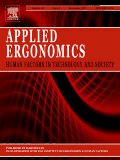
APPLIED ERGONOMICS
Exploring Human Factors to Enhance Safety and PerformanceWelcome to Applied Ergonomics, a premier journal dedicated to advancing knowledge and practice in the multidisciplinary field of ergonomics and human factors. Published by Elsevier Science Ltd, this esteemed journal features a diverse range of research covering critical aspects of physical therapy, human factors, safety, and engineering. With an impressive impact factor and consistently ranked in the Q1 category across multiple domains—including Engineering, Human Factors and Ergonomics, and Safety—Applied Ergonomics serves as a vital resource for researchers, professionals, and students aiming to enhance user experience and optimize workplace safety. With its extensive historical archive dating back to 1969 and continuing through 2025, this journal encourages the dissemination of innovative applications and research findings that contribute to the ergonomics body of knowledge. For those interested in cutting-edge research that directly impacts health and safety practices, Applied Ergonomics is the authoritative source.
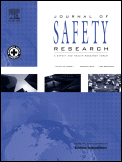
JOURNAL OF SAFETY RESEARCH
Empowering professionals through cutting-edge safety insights.The JOURNAL OF SAFETY RESEARCH, published by Pergamon-Elsevier Science Ltd, stands as a premier platform for scholarly discourse within the domain of safety, risk, reliability, and quality. With an esteemed impact factor and a strong ranking of #38 out of 207 in its category as per Scopus, this journal maintains a distinguished Q1 quartile status, reflecting its influence and significance in advancing safety research since its inception in 1969. Researchers, practitioners, and students alike will find a wealth of knowledge here as the journal explores critical aspects of safety in various contexts, highlighting innovative strategies and empirical findings that contribute to improved safety outcomes globally. Though it operates under a traditional access format, the journal’s extensive repository of articles ensures that vital information remains accessible to its readership. The JOURNAL OF SAFETY RESEARCH is not only a cornerstone for those within the safety engineering field, but also a vital resource for professionals seeking to enhance their understanding of risk management and quality assurance methodologies.

INTERNATIONAL JOURNAL OF INDUSTRIAL ERGONOMICS
Advancing human performance in industrial environments.INTERNATIONAL JOURNAL OF INDUSTRIAL ERGONOMICS, published by Elsevier, is a premier scholarly outlet dedicated to advancing the fields of human factors and ergonomics, as well as public health, environmental, and occupational health. With an impressive Q2 ranking in both relevant categories, this journal serves as a crucial forum for researchers and professionals seeking to share and access high-quality research aimed at optimizing human performance in industrial settings. The journal has been at the forefront of ergonomic research since its inception in 1986, fostering a rich discourse across disciplines and providing invaluable insights that bridge science and practice. While open access options are not available, the journal is widely accessible through institutional subscriptions. With a Scopus Ranking of #118/665 in Public Health and a #10/46 position in Human Factors, it caters to a diverse audience interested in the latest findings and applications in ergonomics, ensuring its relevance in a rapidly evolving field. Join a community dedicated to enhancing workplace safety and efficacy through rigorous research and innovative methodologies.

OCCUPATIONAL AND ENVIRONMENTAL MEDICINE
Advancing health in workplaces and communities.OCCUPATIONAL AND ENVIRONMENTAL MEDICINE is a leading academic journal dedicated to the field of public health, with a specific emphasis on environmental and occupational health. Published by the esteemed BMJ PUBLISHING GROUP, this journal has established itself as a crucial resource for researchers, professionals, and students alike, achieving a remarkable impact factor that reflects its high-quality research contributions. With a distinguished Q1 ranking in its category and a strong position in Scopus rankings—placing it at #59 out of 665—this journal showcases top-tier studies and findings from 1994 to its anticipated convergence in 2024. Set in the United Kingdom, the journal aims to advance understanding and practices relating to health in the workplace and environmental settings, making it an indispensable platform for the dissemination of knowledge in this vital area. Although not an open-access journal, it provides a valuable repository of articles that influence policy and practice worldwide, ensuring that critical information is accessible to those dedicated to promoting safer, healthier working and living environments.

Zentralblatt fur Arbeitsmedizin Arbeitsschutz und Ergonomie
Championing Ergonomics for a Healthier WorkforceZentralblatt für Arbeitsmedizin, Arbeitsschutz und Ergonomie, published by Springer Heidelberg, is a pivotal academic journal dedicated to the fields of public health, occupational safety, and ergonomics. With an ISSN of 0944-2502 and an E-ISSN of 2198-0713, this journal has been serving the academic community since its inception in 1953, covering a breadth of topics related to workplace health and safety practices. Although currently classified in the Q4 quartile in Public Health, Environmental, and Occupational Health, the journal continues to publish valuable research that impacts both practitioners and policymakers in these essential fields. The journal’s scope encompasses a wide range of studies, evaluations, and methodologies aimed at improving occupational health standards and ergonomic practices. With access options that facilitate global dissemination of knowledge, it aims to foster collaboration and innovation among professionals, researchers, and students committed to enhancing workplace well-being and safety.